Decorative Throws
How Many Watts Does an Electric Throw Blanket Use
Stuck on how many watts your electric throw blanket uses? Find out the key factors that affect wattage and make informed decisions.
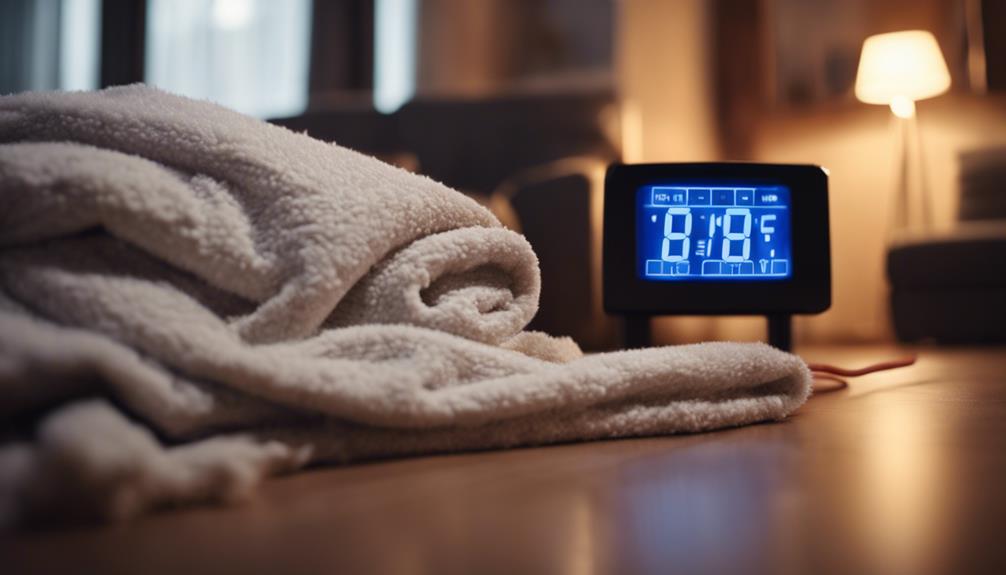
Electric throw blankets typically use between 50 to 200 watts of electricity. The wattage can vary depending on factors such as size, settings, and brand. It's important to understand that higher wattage blankets offer more warmth but consume more electricity. Managing energy effectively involves aligning wattage with personal preferences and needs. For cost-effective usage, selecting the right blanket, adjusting heat settings, and using energy-saving features are vital. To optimize energy consumption and performance, balancing comfort and efficiency is key. So, when considering wattage for an electric throw blanket, be mindful of these factors to make informed decisions.
Key Takeaways
- Electric throw blankets typically consume 60 to 130 watts.
- Lower wattage blankets are more energy-efficient.
- Wattage affects energy consumption and warmth.
- Wattage variations crucial for selecting the right blanket.
- Understanding wattage helps manage electricity costs effectively.
Electric Throw Blanket Power Consumption
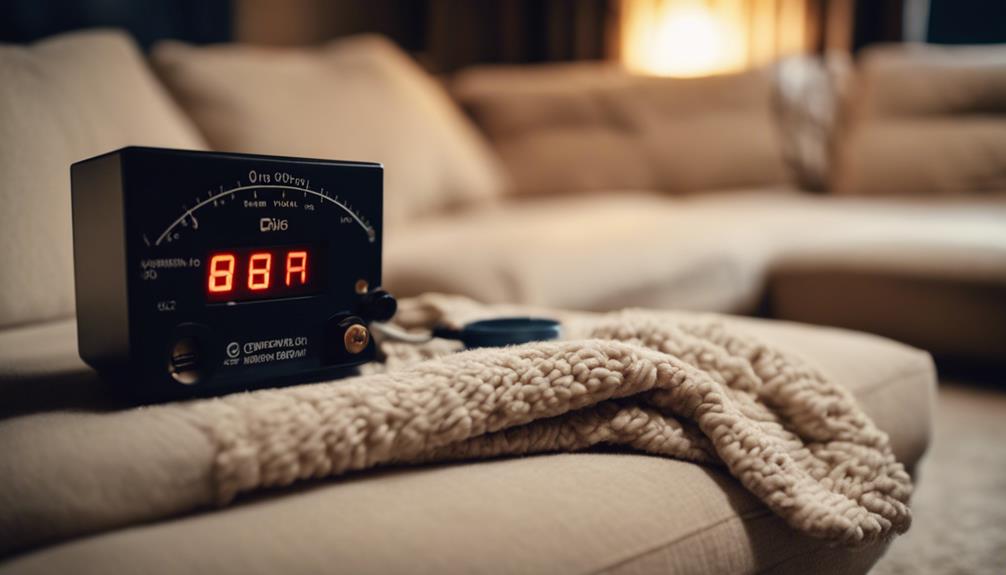
When using an electric throw blanket, the power consumption typically ranges from 50 to 200 watts. The wattage of an electric blanket can vary based on factors such as size, settings, and brand.
A 100-watt electric throw blanket used for 8 hours costs around 12 cents per night, making it an energy-efficient choice for staying warm. Higher wattage blankets may provide more warmth but also consume more electricity, impacting energy costs.
Understanding the wattage of an electric throw blanket is important for managing energy usage effectively and keeping costs in check. By choosing a blanket with the appropriate wattage for your needs, you can strike a balance between comfort and energy efficiency.
Monitoring power consumption and selecting an electric blanket that aligns with your usage patterns can help you save on energy costs while staying cozy. It's important to consider both the comfort offered by the blanket and its energy efficiency to make an informed decision.
Factors Affecting Wattage Usage
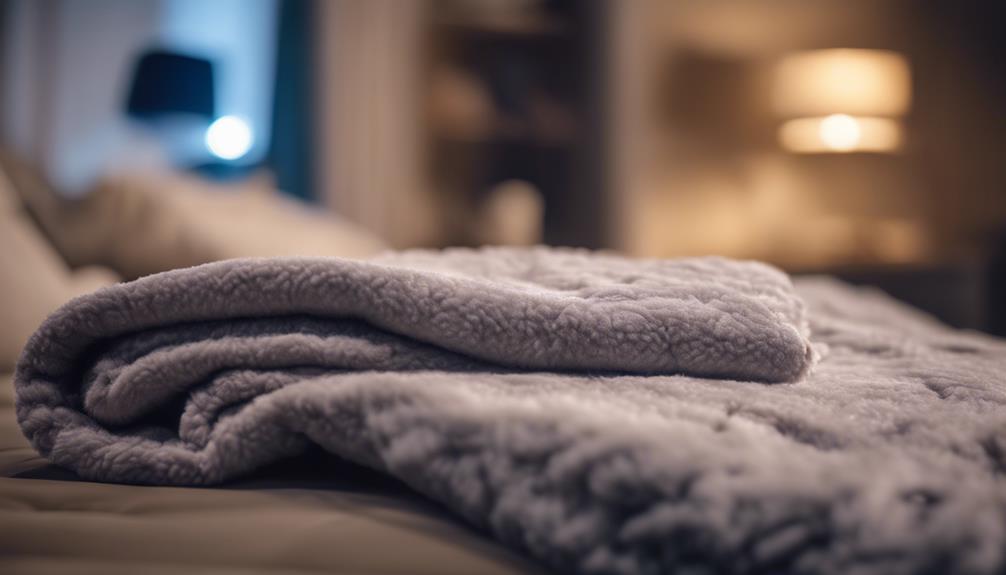
To guarantee efficiency and cost-effectiveness with an electric throw blanket, it's crucial to consider the material, size, and heat settings. These factors can greatly impact wattage usage, which typically ranges from 50 to 200 watts depending on the blanket's size and heating capacity. Blankets with higher heat settings consume more electricity than those set at lower levels. Aligning the wattage with your energy consumption preferences is important, as monitoring usage helps manage energy effectively while optimizing comfort. Selecting the right size, material, and heat settings tailored to your needs ensures efficient operation without unnecessarily increasing energy costs. Understanding and making informed decisions based on these factors can lead to a comfortable and cost-effective experience with your electric throw blanket.
Wattage Range for Electric Throw Blankets
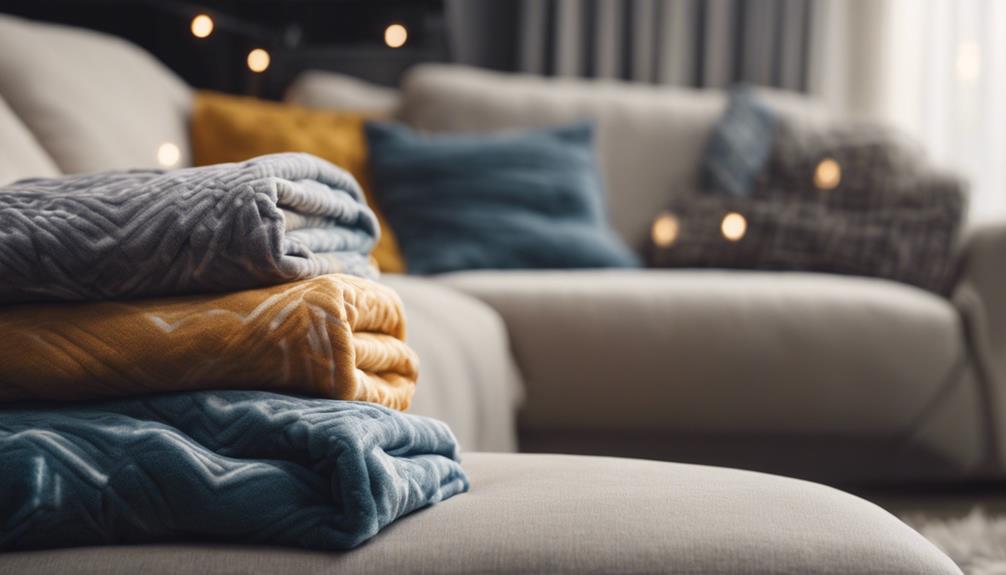
Electric throw blankets come in a range of wattages, typically falling between 60 to 130 watts.
Understanding these variations is important for selecting the right level of warmth and energy efficiency.
Wattage Variations Explained
Exploring the wattage variations of electric throw blankets sheds light on their energy consumption and performance capabilities. Here are key points to keep in mind:
- Wattage Range: Electric blankets typically consume 60 to 100 watts, but larger sizes or higher heat settings may reach up to 200 watts.
- Energy Efficiency: Lower wattage blankets are more energy-efficient for extended use, helping to reduce electricity costs.
- Factors Affecting Wattage: The size, material, and heating elements of the blanket influence its wattage requirements.
- Selecting the Right Blanket: Understanding the wattage variations is essential in choosing an electric throw blanket that aligns with your energy efficiency goals and heating needs.
Energy Efficiency Tips
For optimal energy efficiency when using electric throw blankets, it's important to consider the wattage range to ensure cost-effective warmth. Electric blankets typically range from 60 to 130 watts, with energy-efficient models consuming approximately 0.06 kWh per hour.
Choosing a low-wattage blanket can provide comfort while keeping electricity costs down. However, blankets with higher wattage may offer faster heating at the expense of increased power consumption.
To balance warmth and energy efficiency, selecting a blanket with adjustable heat settings allows for personalized control over power usage. By choosing the appropriate wattage and adjusting settings based on personal comfort needs, individuals can enjoy the benefits of electric blankets while effectively managing electricity costs.
Safety Considerations for Usage
Considering safety when using electric throw blankets involves making sure that the wattage of the blanket aligns with the power source's capacity to prevent overheating risks. It's important to follow manufacturer guidelines on wattage usage to maintain safety and prevent electrical issues. Opting for lower wattage electric throw blankets can offer energy-efficient and cost-effective heating solutions while ensuring safety. Understanding the wattage range of electric throw blankets enables users to select the appropriate heating level for comfort and safety.
- Follow manufacturer guidelines for wattage usage.
- Opt for lower wattage blankets for energy efficiency.
- Make sure the blanket's wattage aligns with the power source's capacity.
- Select the appropriate heating level for comfort and safety.
Understanding Electricity Costs
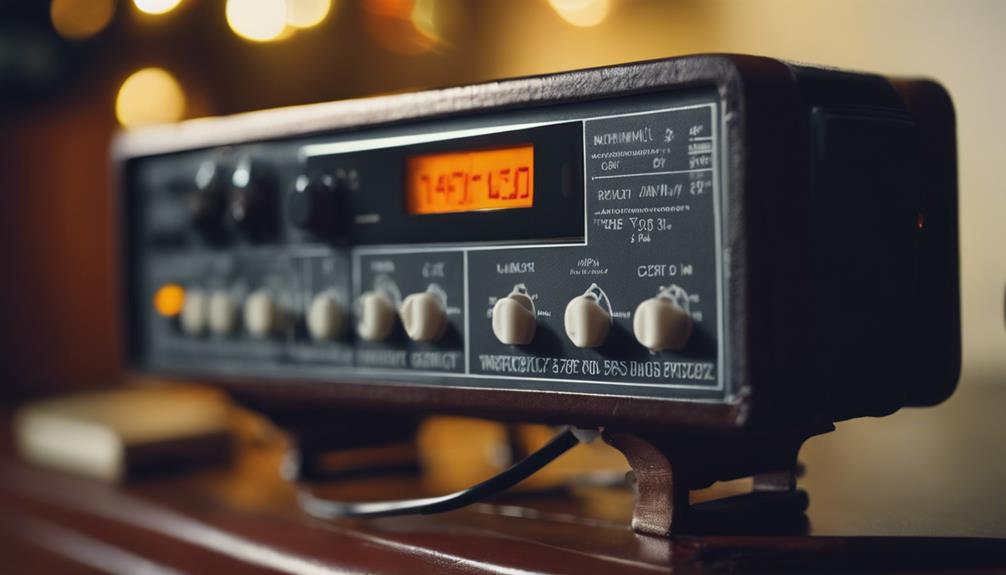
Understanding electricity costs can be simplified by analyzing the power consumption of specific household appliances. When it comes to electric blankets, they typically use around 100 to 150 watts of power.
For instance, using an electric throw blanket for 6 hours a night over 4 months adds up to approximately 108 kWh per year. Compared to high-power appliances like washing machines, the cost of keeping warm with an electric blanket is relatively low, around 15.44 euros annually.
Running an electric throw blanket for a minute costs about 0.0003575 euros, while each hour of use amounts to roughly 0.02145 euros. Despite providing cozy warmth, the energy consumption of an electric throw blanket actually represents only 1.37% of the average annual household electricity consumption.
Energy Efficiency of Electric Throw Blankets
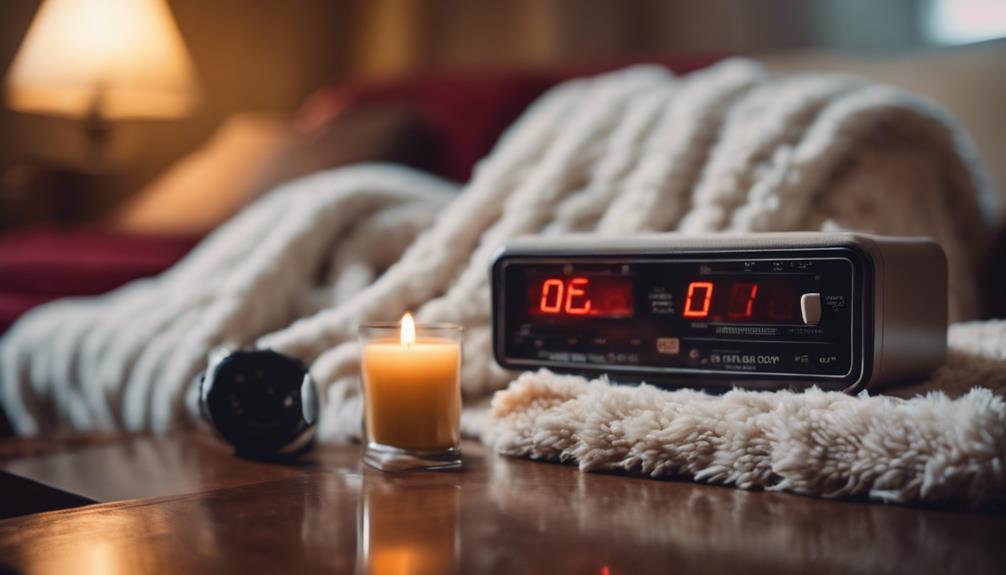
Electric throw blankets, known for their energy-efficient heating capabilities, typically operate within a power range of 60 to 130 watts. When considering the energy efficiency of electric blankets, understanding their impact on electricity consumption and heating options is crucial.
Here are key points to help you grasp the efficiency of these blankets:
- Low Power Usage: Electric blankets consume relatively low watts of power compared to other heating devices, making them efficient choices for staying warm.
- Cost-Effective Heating: The energy consumption of electric throw blankets translates to around 1 to 3 cents per hour of use, offering cost-effective heating solutions.
- Moderate Electricity Consumption: Using an electric throw blanket for an average of 6 hours nightly over a month results in consuming approximately 11 to 23 kilowatt-hours (kWh) of electricity.
- Reduced Impact on Bills: Proper usage and care of electric throw blankets can help maintain comfort without significantly increasing electricity bills, showcasing their energy-efficient design.
Managing Power Usage Effectively
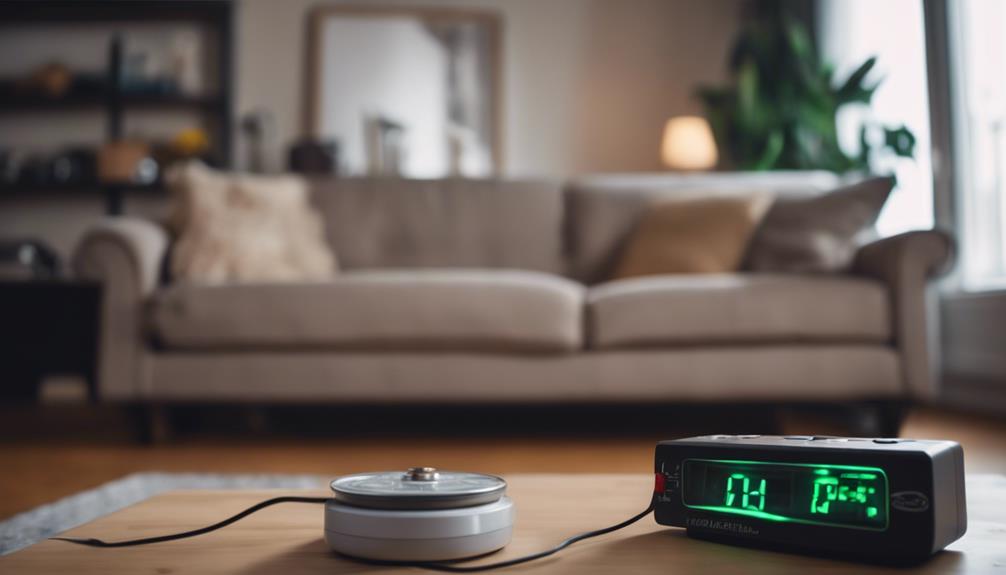
To manage power usage effectively with an electric throw blanket, we can implement power-saving tips and utilize energy-efficient settings.
Adjusting the blanket's timer to turn off after a certain period or using it in conjunction with other bedding can help optimize energy consumption.
Power-Saving Tips
By adjusting the heat setting to a lower level, significant reductions in power consumption can be achieved when using an electric throw blanket.
To effectively manage power usage and promote energy efficiency, consider the following tips:
- Utilize a Timer: Set a timer on the electric blanket to automatically turn it off after a specific period, saving energy when not needed.
- Power Strip Convenience: Plug the electric throw blanket into a power strip with an on/off switch for easy power management, allowing you to cut power when not in use.
- Avoid Extra Layers: Refrain from layering additional blankets on top of the electric throw to maintain efficiency and prevent overheating, optimizing energy consumption.
- Regular Inspections: Check the wiring of the electric blanket regularly for any damage to ensure peak performance, safety, and minimal energy waste.
Energy-Efficient Settings
Optimizing the heat settings on an electric throw blanket can effectively manage power usage, ensuring both energy efficiency and comfort.
By adjusting the heat settings to lower levels or utilizing timers, it's possible to reduce electricity consumption without sacrificing warmth. These energy-efficient settings not only optimize power consumption but also help lower electricity costs in the long run.
Maintaining a balance between comfort and energy efficiency is key when using an electric throw blanket. Choosing the appropriate heat settings based on personal preference and insulation levels can make a significant difference in power usage.
Taking advantage of the various energy-efficient features can lead to a more sustainable and cost-effective use of electric throw blankets.
Frequently Asked Questions
Do Electric Throws Use a Lot of Electricity?
Electric throw blankets don't consume a lot of electricity. They're energy-efficient heating options, typically using 100 to 150 watts.
By using an electric throw blanket for 6 hours a night over 4 months, one consumes about 108 kWh per year. This results in a cost of approximately 15.44 euros annually, making them a cost-effective choice.
Efficient usage and controlling the duration of operation can help reduce electricity consumption even further.
How Many Watts Is a Electric Throw Blanket?
We recognize the significance of knowing the wattage of an electric throw blanket. It typically ranges from 50 to 200 watts, depending on size and heating capacity.
This information is vital for selecting appropriate power sources and optimizing energy use. By monitoring wattage consumption, one can minimize costs and enhance efficiency.
Having this knowledge allows for better decision-making when using electric throw blankets.
How Much Power Does an Electric Throw Rug Use?
When it comes to the power usage of an electric throw rug, understanding the wattage it consumes is essential. The wattage varies based on factors like size, heating elements, and settings. By opting for a lower heat setting, we can reduce the power consumption.
Running an electric throw rug for 8 hours typically costs 10 to 30 cents in electricity. Modern designs prioritize energy-efficiency while ensuring warmth and comfort for users.
How Long Will a Jackery 500 Run an Electric Blanket?
We can run an electric blanket for about 7 hours using a Jackery 500.
This portable power source is perfect for outdoor trips where warmth is essential. Its consistent energy output guarantees uninterrupted comfort in various settings.
The Jackery 500's ability to power an electric blanket for an extended period makes it a valuable asset for outdoor activities or camping trips.
Conclusion
To sum up, it's important to take into account that electric throw blankets typically use around 60-120 watts of power, depending on the settings and size of the blanket.
While some may argue that using an electric blanket can increase electricity costs, it's crucial to think about the energy efficiency and effectiveness of these blankets in providing warmth, ultimately saving on heating bills in the long run.
By managing power usage effectively, electric throw blankets can be a cost-effective and cozy addition to your home.
Decorative Throws
How Many Skeins to Make a Throw Blanket?
Keen to know how many skeins you need for a throw blanket? Find out the key to perfecting your cozy creation in a single sentence!

When crafting a throw blanket, the number of skeins you'll need depends on yarn weight, blanket size, stitch patterns, and color changes. Worsted Weight Yarn usually requires 8-12 skeins, while a Bulky Weight may need 6-10 skeins. For a cozy 30 x 40-inch throw, around 6-10 skeins are typically sufficient. Consider thicker yarn for a denser blanket or a larger size, like a 50 x 60-inch throw needing 12-18 skeins. Calculating wisely now guarantees your project's success and helps avoid running out of yarn later. Rest assured, creating your perfect throw is just a few skeins away!
Key Takeaways
- Yarn weight and blanket size influence skein quantity.
- Thicker yarn weights require fewer skeins for a throw blanket.
- Consider stitch pattern density for accurate yarn estimation.
- Plan for extra skeins to accommodate any variations.
- Calculate yarn needs based on blanket area and design choices.
Factors Affecting Skein Quantity
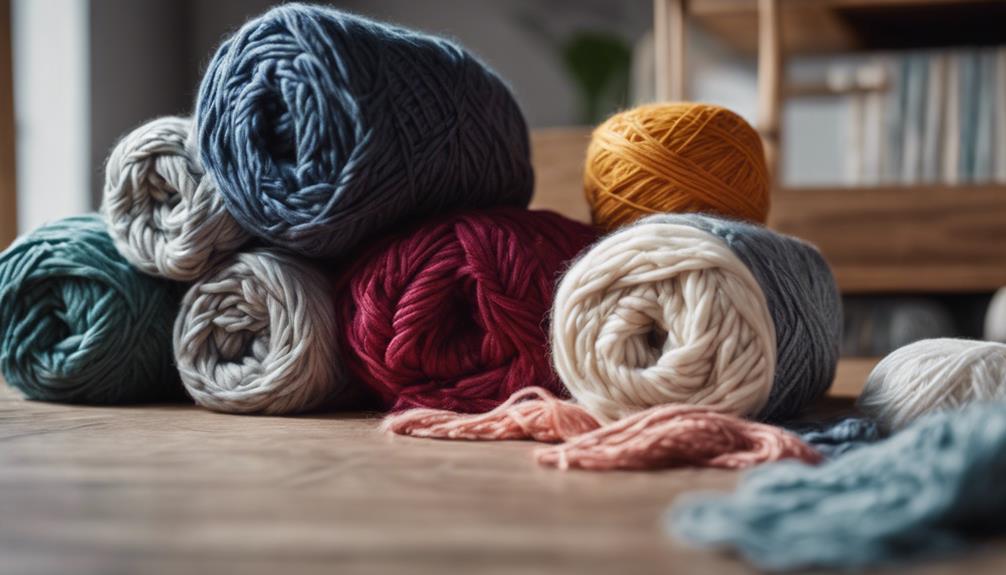
When planning your throw blanket project, consider how yarn weight and stitch type directly impact the number of skeins required. The yarn weight you choose plays a significant role in determining how many skeins you'll need. Thicker yarn weights like chunky or bulky require fewer skeins compared to lighter weights such as fingering or sport. Additionally, the stitch type you use can affect the overall skein quantity. Dense stitches, like the single crochet, tend to use up more yarn, while holey stitches, such as the chain stitch, use less yarn, impacting the total number of skeins needed for your throw blanket.
Crochet tension is another important factor to keep in mind. Tight tension will require more yarn than loose tension. This means that if you tend to crochet tightly, you may need to purchase extra skeins to complete your project. Color changes within the pattern can also impact the skein quantity, potentially resulting in yarn waste or leftover skeins.
Considering your personal crocheting style, stitch complexity, and color choices will help you accurately determine the number of skeins required for your throw blanket project.
Yarn Weight Considerations
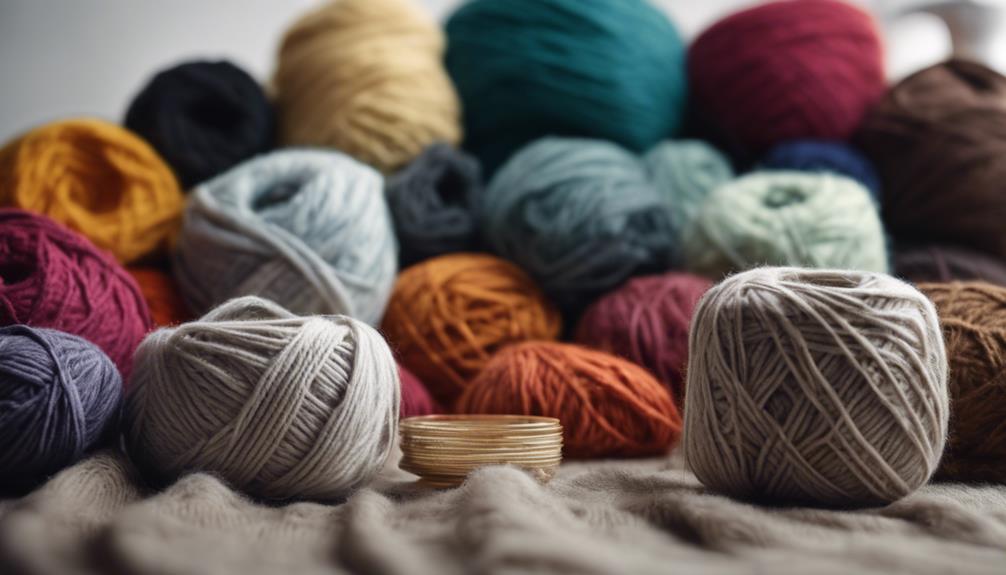
Taking into account the yarn weight is essential when determining the number of skeins needed for your throw blanket project. Consider the following when choosing the yarn weight for your crochet blanket:
- Worsted Weight Yarn: This weight typically requires 8-12 skeins for a standard throw blanket.
- Bulky Weight Yarn: Bulky yarn is thicker and will need around 6-10 skeins to create a cozy throw blanket.
- Super Bulky Weight Yarn: If you opt for super bulky yarn, you may only need 5-8 skeins to crochet a thick and warm throw blanket.
- Thickness and Drape: Keep in mind the desired thickness and drape of your blanket. Thicker yarns will require fewer skeins to achieve a similar size due to their bulkiness.
Blanket Size Impact

Considering the impact of blanket size on your project, the number of skeins required for your throw blanket can vary greatly. Blanket sizes range from 50 x 60 to 50 x 70 inches, and this variation directly affects the amount of yarn needed. Larger throw blankets may demand 8 to 15 skeins, depending on factors like yarn weight and stitch pattern.
For a standard-sized throw blanket, you might need approximately 1000 to 2000 yards of yarn, equivalent to 8 to 12 skeins. Thicker yarn weights such as chunky yarn may require fewer skeins compared to lighter weights like fingering or sport.
When planning your blanket project, consider the stitches per area of your swatch, the desired drape, warmth, and stitch density. To calculate your yarn needs for a crochet or knit throw, keep in mind the dimensions of the blanket and the characteristics of the yarn you choose.
Stitch Pattern Influence
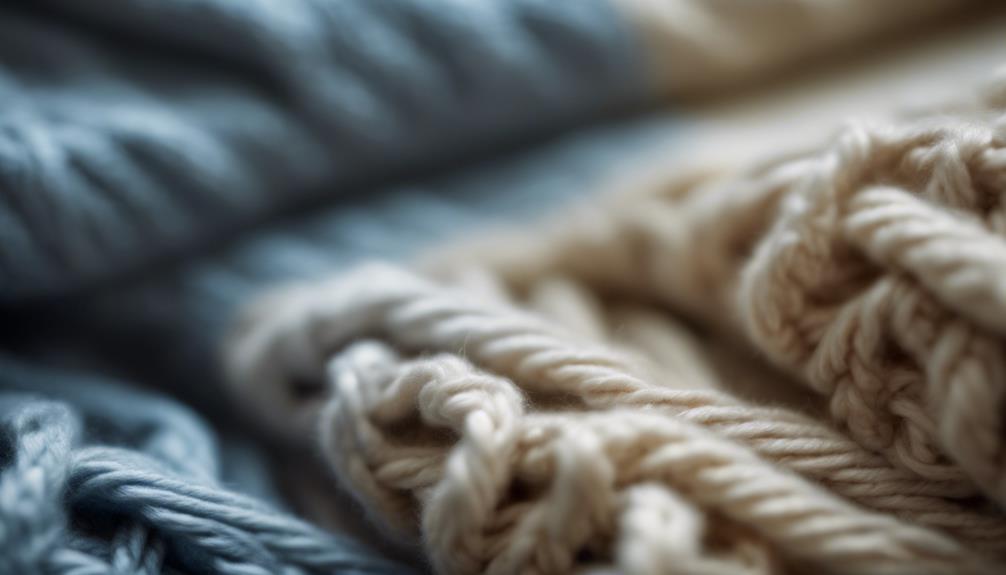
To determine the amount of yarn needed for your throw blanket, the stitch pattern you choose plays a significant role in influencing the quantity of skeins required. When selecting a stitch pattern for your crochet project, consider the following factors:
- Dense Stitch Patterns: Dense stitch patterns like moss or basketweave may require more yarn due to their thickness and compactness.
- Open Stitches: On the other hand, open and lacy stitches use less yarn as they're airy and have more gaps between stitches.
- Complex Stitches: Intricate stitch patterns with many details tend to use up more yarn, making them suitable for projects where you want a rich texture.
- Simple Stitches: Basic stitches like single crochet or double crochet typically use less yarn, making them efficient choices for projects where yarn conservation is important.
Considering these aspects will help you estimate the amount of yarn needed accurately for your throw blanket based on the stitch pattern you choose.
Color Changes Effect
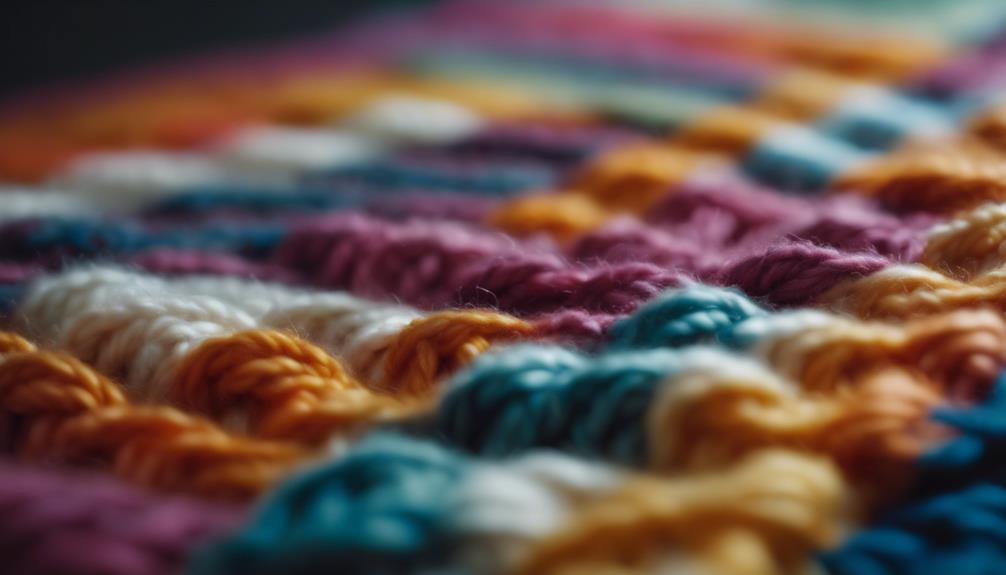
When you change colors in your throw blanket, it can affect how much yarn you'll need and create a unique look.
The variations in color can add visual interest and impact the overall aesthetic of your project.
Think about how the colors will flow together and how often you'll switch them to achieve the desired pattern continuity.
Impact of Color Changes
Color changes in your crochet projects can impact yarn usage and create excess waste if not managed effectively. To minimize waste and handle leftover yarn, strategic planning is key.
Consider carrying yarn up the side to reduce ends that need weaving in. Think about how different stitch patterns and color change placements will affect the overall look of your throw blanket.
Visual Appeal Variations
Enhancing the visual appeal of your throw blanket can be achieved through strategic color changes that create a cohesive and alluring design. When planning the color sequence, consider the impact on yarn quantity and potential shift waste.
Multiple color changes add complexity and beauty but may also result in leftover yarn. To minimize waste and guarantee a visually appealing result, strategize your color modifications. Estimate the amount of each yarn color needed in advance to avoid running out mid-project.
Pattern Continuity Considerations
Considering pattern continuity in your throw blanket design can greatly impact the efficiency of yarn usage and minimize leftover yarn. When planning your pattern design, strategic color changes play an essential role in minimizing waste and enhancing the visual appeal of your project.
Here's how you can make the most of your yarn and crocheting process:
- Opt for a cohesive color scheme: Choosing colors that flow well together can reduce the need for frequent yarn changes.
- Create a gradient effect: Switching smoothly from one color to another can add depth to your blanket while efficiently managing yarn quantities.
- Plan color changes strategically: Mapping out where and when to change colors can streamline your crocheting process and reduce excess yarn usage.
- Maintain pattern consistency: Keeping a consistent design can help you use up yarn more efficiently and achieve a polished look.
Stitch Tension's Role
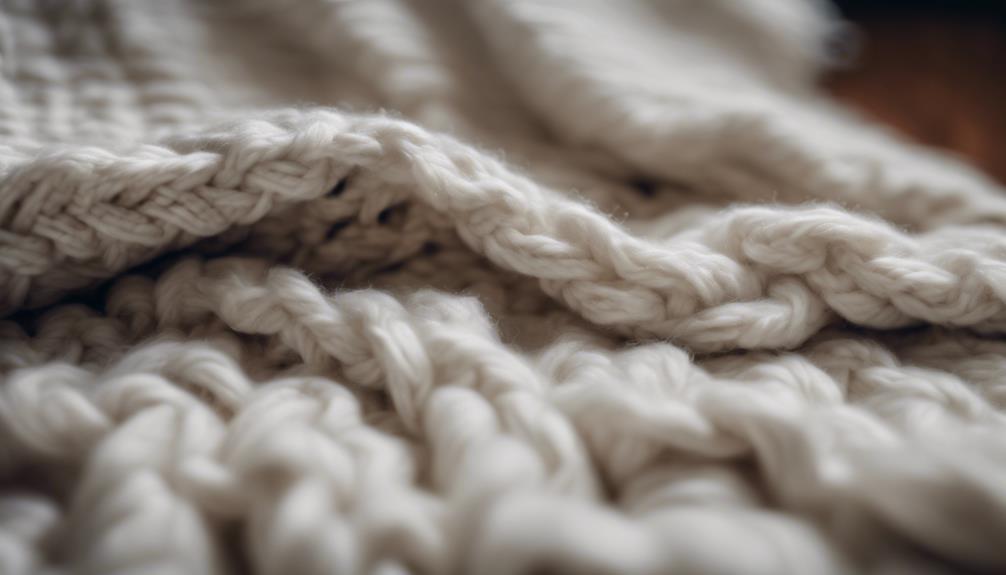
Stitch tension plays a crucial role in determining the amount of yarn needed for a throw blanket project. When crocheting throw blankets, your stitch tension affects yarn usage. If you have consistent stitch tension throughout the project, estimating the skeins needed becomes more accurate.
Tighter tension consumes more yarn, while looser tension requires less. Varied stitch tension can result in inconsistencies in yarn usage and the overall size of your blanket. To maintain a uniform appearance, monitoring and adjusting your stitch tension as you work is important.
Determining Yarn Yardage

To accurately determine the yarn yardage needed for a throw blanket, factor in the blanket size, yarn weight, and crochet tension. When deciding on the total yardage required, consider the following:
- Baby Blanket: If you're making a baby blanket, the size will be smaller than a standard throw blanket, affecting the amount of yarn needed.
- DK Weight Yarn: Using DK weight yarn is common for blankets; however, different yarn weights will require different amounts for the same size blanket.
- Calculate How Much Yarn: You can calculate how much yarn you need per square inch and then multiply it by the total number of square inches in your blanket.
- Swatch Using: Make a gauge swatch using the yarn and stitch pattern you plan to use for your blanket to get an accurate estimate of the yardage required.
Calculating Skeins Needed
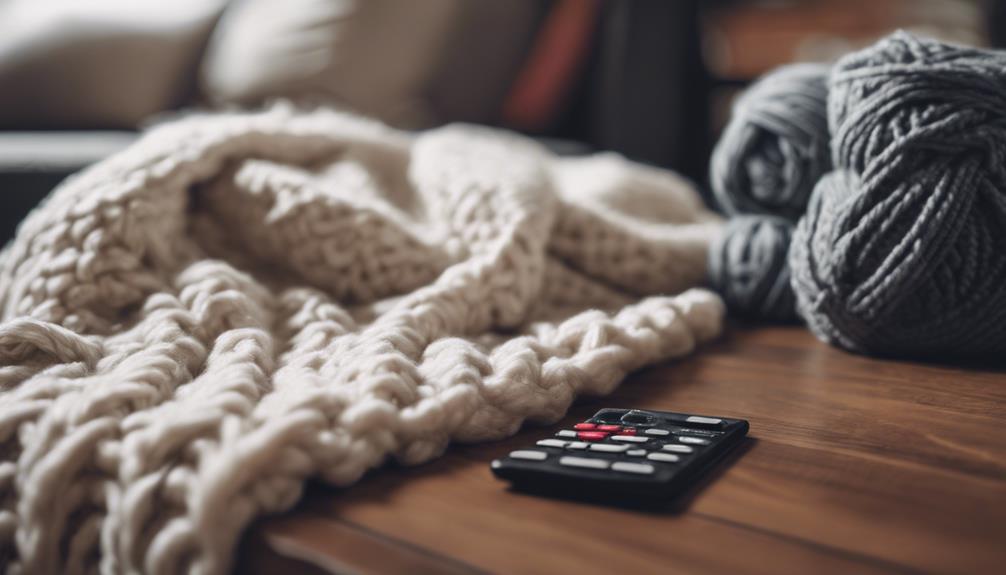
When determining how many skeins are needed for a throw blanket, you'll want to take into account factors like yarn weight and the size of the blanket. These elements play an important role in calculating the right amount of yarn for your project.
Yarn Weight Considerations
Considering the weight of the yarn you choose is essential when calculating the number of skeins needed for your throw blanket. Here are some key points to keep in mind:
- Baby blankets often require lighter weight yarn such as fingering yarn.
- Different yarn weights like bulky or super bulky can impact the number of skeins needed.
- The size of the blanket and the stitches used also influence the amount of yarn required.
- Always match the yarn material and hook size to the pattern for the best results.
Size of the Blanket
Calculating the number of skeins needed for your throw blanket is influenced by the desired size you intend to create. If you aim for a blanket around 30 x 40 inches, you might require approximately 6-10 skeins of yarn.
However, if you envision a larger throw, say 50 x 60 inches, you could need 12-18 skeins. To determine the amount of yarn needed accurately, calculate the total yarn by considering the area of your blanket.
Factors such as yarn weight, stitch density, and importance play a vital role in estimating how much yarn you need for your project. When planning, it's wise to purchase extra skeins to accommodate any variations in dye lots, pattern adjustments, or unexpected yarn usage.
Adjusting for Blanket Thickness
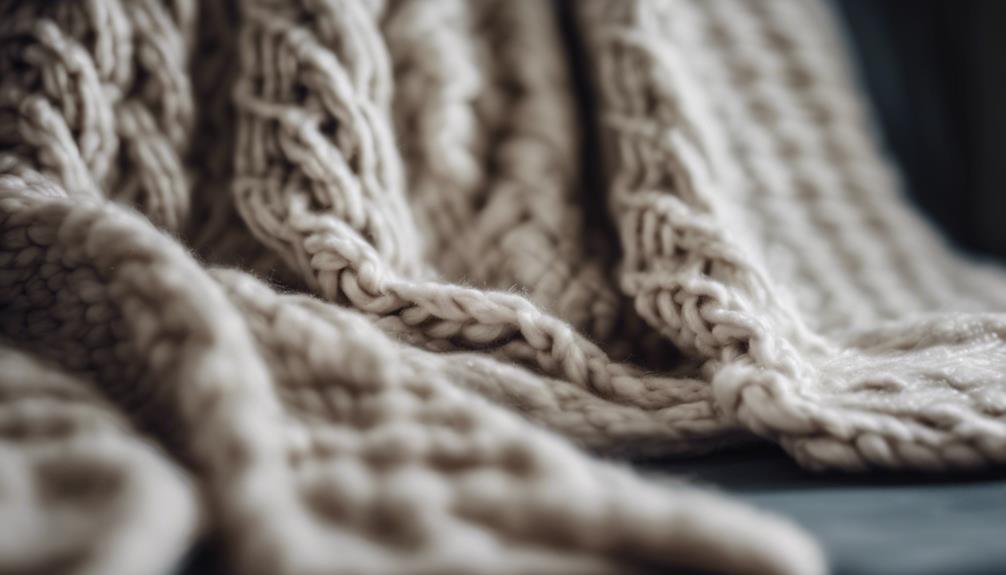
To adjust for blanket thickness, you may opt to use double or triple-stranded yarn to create a denser and warmer throw. Here are some tips to help you adjust your yarn quantity based on the desired thickness of your blanket:
- Consider the Yarn Requirements: Thicker blankets generally require more yarn per square inch than lighter throws.
- Choose Bulky Yarns: Incorporating bulky yarns can help you achieve a denser throw for added warmth.
- Experiment with Crochet Hook Size: Using a larger hook size can create a looser, more open stitch pattern, perfect for a lighter throw.
- Calculate How Much Yarn You Need: Adjust the amount of yarn you purchase based on the desired thickness and drape of your throw blanket.
Frequently Asked Questions
How Many Yarns Do I Need to Make a Throw Blanket?
To make a throw blanket, you'll need a specific amount of yarn, depending on the size and thickness you desire. Thicker yarns like bulky types require fewer skeins than thinner ones. Calculating the total yardage based on your pattern or dimensions helps determine the required skeins.
Consider your stitch pattern, tension, and color changes for a precise estimate. It's smart to get extra skeins for gauge variations, potential mistakes, or for adding borders or embellishments.
How Much Yarn Do I Need for a 40X60 Blanket?
When making a 40×60 blanket, ensuring you have the right amount of yarn is essential. Various factors like yarn weight, stitch density, and personal tension impact the total yarn needed.
Consider elements such as stitch type, tension, and color changes for accurate estimates. Yarn weight and fiber content also play a role.
Calculating total yardage based on specific dimensions and characteristics is vital to avoid running out of yarn mid-project.
How to Calculate How Many Skeins of Yarn for a Blanket?
To calculate how many skeins of yarn you need for a blanket, consider factors like yarn weight, blanket size, and stitch pattern. Account for yardage per skein, total yardage required, and potential variations in yarn types.
Tension, stitch density, and color changes impact yarn usage. Consult yarn labels, patterns, and online resources for accurate estimations.
Swatch and track yarn usage for precise calculations in your throw blanket project.
How Many Skeins of Chunky Yarn Do I Need to Make a Throw?
You'll typically need around 5 to 10 skeins of chunky yarn for a cozy throw. The thicker yarn means fewer skeins, but size and stitch choice play a role.
Keep in mind your crochet tension too. It's smart to snag some extra skeins to cover variations in thickness or any hiccups along the way.
With the right yarn and a bit of extra on hand, you'll be all set to craft your perfect throw blanket.
Conclusion
So, next time you're planning to make a throw blanket, remember that the number of skeins you'll need can vary based on factors like yarn weight, blanket size, stitch pattern, color changes, and stitch tension.
Just like a painter needs different colors to create a masterpiece, a knitter needs the right amount of yarn to craft a cozy masterpiece.
Happy crafting!
Decorative Throws
What Is the Point of a Throw on a Bed?
Jazz up your bed with a throw for added warmth and style, but there's more to discover – keep reading to uncover its full potential!
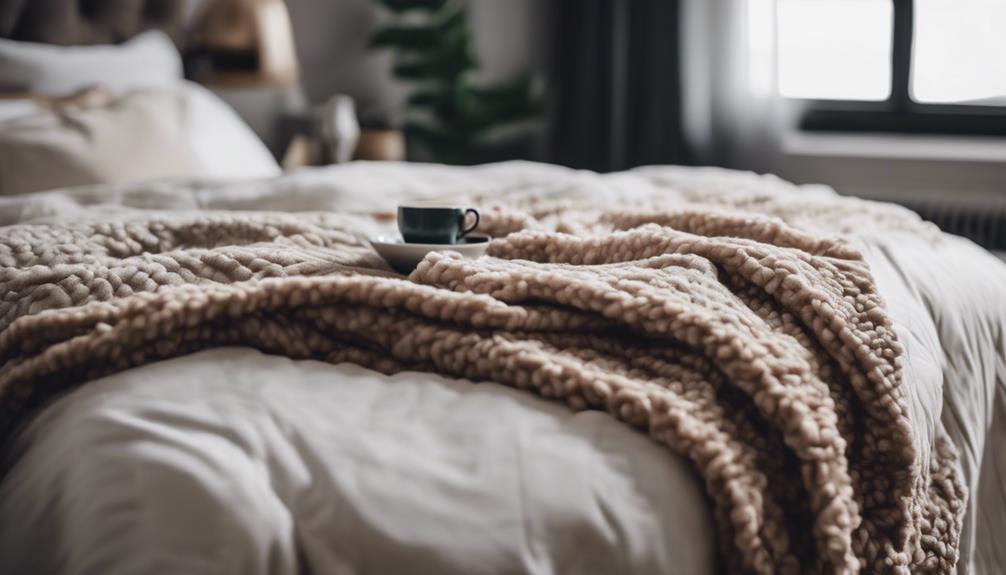
Adding a throw to your bed serves a dual purpose: snuggling up on chilly nights and sprucing up your bedroom with style. Whether you opt for silky luxury or practical man-made fibers, throws offer warmth and versatility. They elevate your decor by introducing color, texture, and patterns effortlessly. Want to protect your bedding from spills or change the vibe of your room with the seasons? A throw has got you covered. Uncover more ways throws can enhance your bedroom oasis by exploring their aesthetic and practical benefits today!
Key Takeaways
- Adds extra warmth and comfort on chilly nights.
- Enhances bedroom decor with color and texture.
- Protects bedding from spills, stains, and wear.
- Easily updates room decor with different styles.
- Provides a quick and effortless room refresh.
Added Layer of Warmth
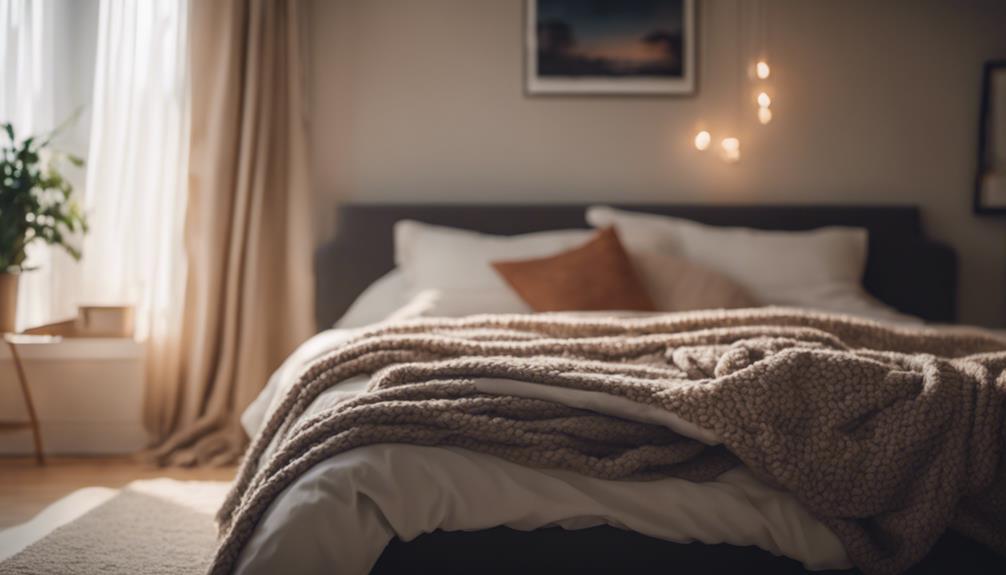
Adding a throw to your bed provides an extra layer of warmth, perfect for chilly nights without the bulk of a heavier blanket. Throw blankets are versatile additions that can be used to keep you cozy while lounging in bed, reading a book, or watching a movie. These throws come in a variety of materials, such as silk or man-made fibers, each offering unique benefits.
Silk throws are luxurious and soft, adding a touch of elegance to your bedding ensemble. On the other hand, man-made fiber throws are often more affordable and easier to care for, making them practical choices for everyday use.
Whether you prefer the silky smoothness of a silk throw or the easy maintenance of a man-made fiber throw, both options serve the purpose of providing that extra warmth you crave on colder nights. So, next time you're getting ready to snuggle up in bed, don't forget to grab your favorite throw to stay cozy and comfortable throughout the night.
Decorative Element for Bed
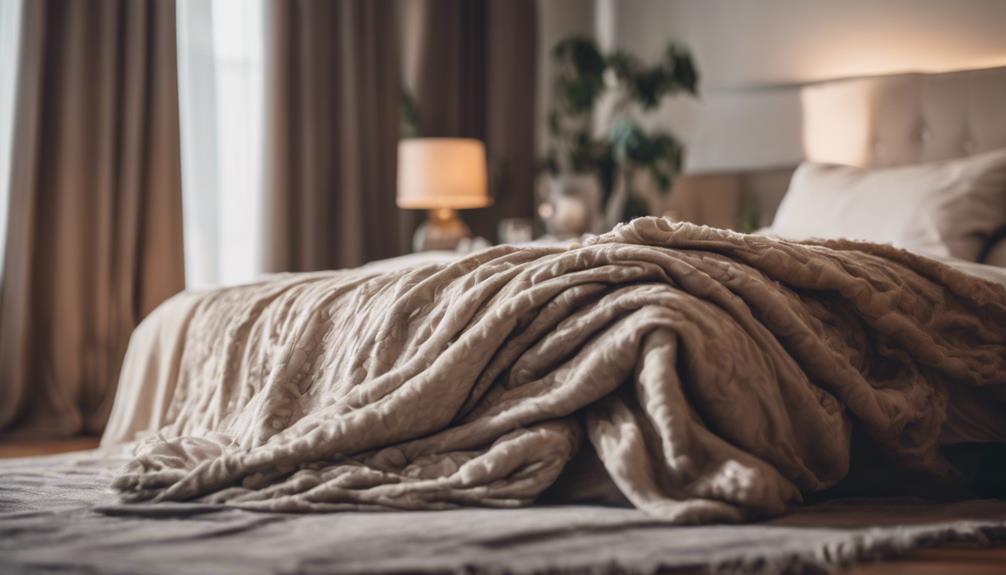
Adding a throw to your bed is like putting the cherry on top of a sundae – it brings the whole look together.
The colors and textures of the throw can add warmth and coziness to your bedroom, giving it a stylish layered appearance.
Bed Throw Colors
Enhancing the visual appeal of your bed, bed throw colors serve as a key decorative element that can tie together various aspects of your bedroom decor. They're often made from man-made fibers, with polyester being a popular fabric used for its durability and easy maintenance.
Bed throws come in a variety of colors, allowing you to choose shades that complement or contrast with your existing bedding and room decor. By selecting the right throw color, you can create a cohesive and harmonious design scheme in your bedroom.
Whether you opt for bold and vibrant hues to add a pop of color or prefer subtle tones for a more understated look, bed throw colors offer a quick and easy way to update the appearance of your bed without a major decor overhaul.
Texture Adds Warmth
Introducing a soft throw to your bed instantly infuses a touch of warmth and texture into your bedroom decor. Here are five reasons why adding a throw to your bed is a great idea, especially for summer:
- Throws with lightweight materials like cotton or linen are great for summer, providing just the right amount of warmth without overheating.
- The texture of a throw adds depth to your bedding ensemble, creating a cozy and inviting atmosphere in your bedroom.
- A throw can introduce a pop of color or a fun pattern to your bed, enhancing the overall look and feel of the space.
- Switching out throws is an easy way to refresh your bedding decor, allowing for quick and effortless updates to your bedroom's style.
- Personalize your bed with a throw that reflects your unique taste and preferences, adding a personal touch to your sanctuary.
Layering for Style
Layer your bed with a stylish throw to elevate the decor and create a cozy ambiance in your bedroom effortlessly. Adding a throw as a layer on your bed not only enhances the style of your bedding but also introduces color, texture, and pattern to the overall look. By incorporating a throw, you can easily refresh your bedroom decor without needing to completely change your bedding. This simple addition provides a warm and inviting atmosphere, perfect for relaxation. Additionally, using a throw as a finishing touch helps tie together the different elements of your bedding ensemble, resulting in a cohesive and well-designed space.
| Benefits of Layering a Throw on Your Bed |
|---|
| Adds decorative element |
| Introduces color, texture, and pattern |
| Easily refreshes bedroom decor |
Versatile Styling Option
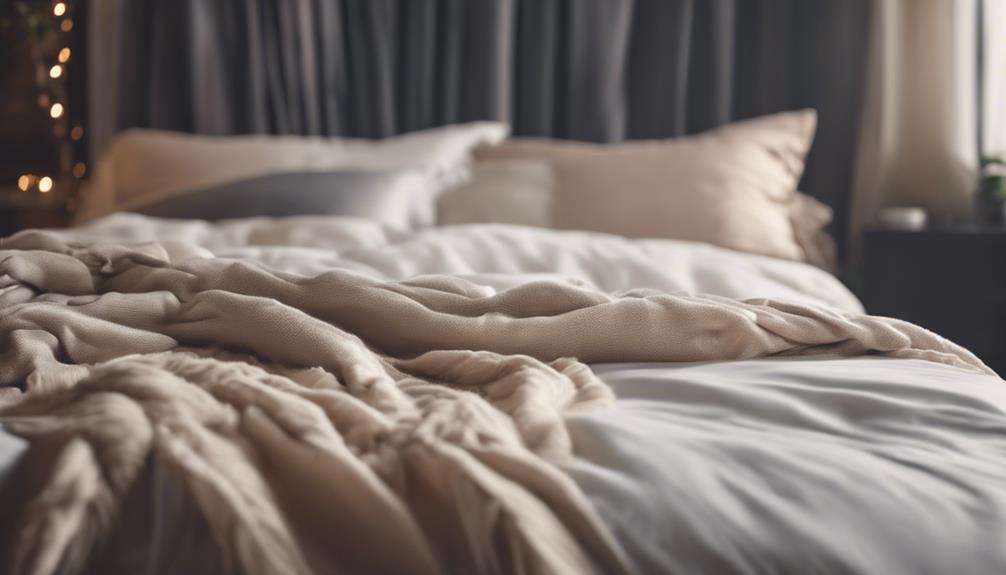
When styling your bed, incorporating a throw offers a versatile option to effortlessly elevate the overall look. Throws on a bed can add a pop of color, texture, and pattern to the bedding ensemble. Here are five ways throws can enhance your bedroom decor:
- Color Splash: Choose a throw in a bold or contrasting color to make a statement and add visual interest to your bed.
- Texture Play: Opt for a throw with different textures like knits, faux fur, or woven patterns to create depth and coziness.
- Pattern Mix: Experiment with mixing patterns by layering a patterned throw over solid bedding for a trendy and eclectic look.
- Cozy Corner: Drape a throw over a corner of the bed to create a relaxed and inviting atmosphere, perfect for curling up with a book.
- Seasonal Switch: Easily update your bedroom decor by swapping out throws with seasonal colors or themes to keep your space feeling fresh and stylish.
Protection for Bedding
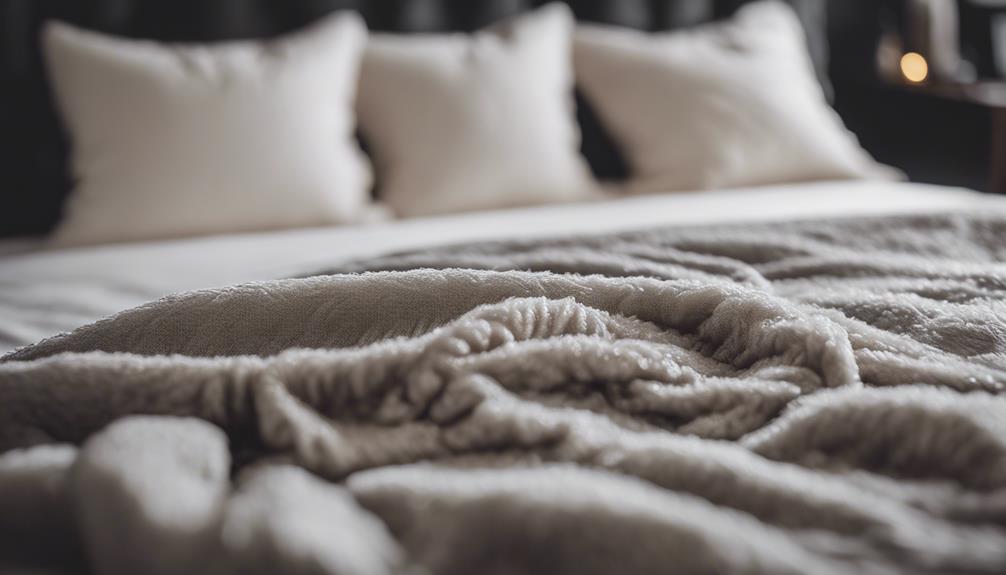
To safeguard your bedding against spills, stains, and pet hair, utilizing throws on your bed serves as a practical solution to extend the longevity of your duvets, blankets, and bedspreads. Throws act as a protective barrier, shielding your bedding from potential sources of dirt or damage. They make it easy to wash and maintain, ensuring your main bedding stays clean and fresh. By adding a throw to your bed, you add an extra layer of defense against wear and tear, preserving the appearance and quality of your bedding underneath.
Not only do throws protect your bedding, but they also prevent direct contact with oils, lotions, or other substances that may transfer from your body. This helps in maintaining the cleanliness of your duvets and blankets. Additionally, throws offer a convenient way to change the look of your bedroom easily and affordably. You can switch up the style or color of your throw to refresh your room's appearance while keeping your main bedding protected and in top condition.
Easy Room Refresh

Adding a bed throw is like giving your room a mini makeover!
It's a simple way to switch up the look and feel of your space with little effort.
Decorative Accents for Bed
Enhance your bedroom decor effortlessly by incorporating bed throws as stylish decorative accents.
- Color Splash: Add a vibrant throw to inject a pop of color into your room.
- Texture Play: Choose a throw with a different texture to create visual interest.
- Pattern Mix: Opt for a throw with a bold pattern to liven up a neutral bedding set.
- Layering Magic: Layer different throws for a cozy and inviting look.
- Seasonal Switch: Easily update your bedroom's look with seasonal throws for a fresh feel throughout the year.
Quick Style Update
For a swift room makeover, consider incorporating bed throws to instantly liven up your space. Throws on a bed offer a quick and easy style update, adding a pop of color, texture, and warmth to your bedding ensemble.
They can be easily changed out to suit different seasons or design preferences, providing a versatile way to layer bedding and create a cozy atmosphere in your bedroom. By using a throw on your bed, you can enhance the overall aesthetic of the room in a simple yet effective manner.
Whether you prefer a bold statement piece or a subtle addition, bed throws are a fantastic way to refresh your room without a major overhaul.
Seasonal Coordination
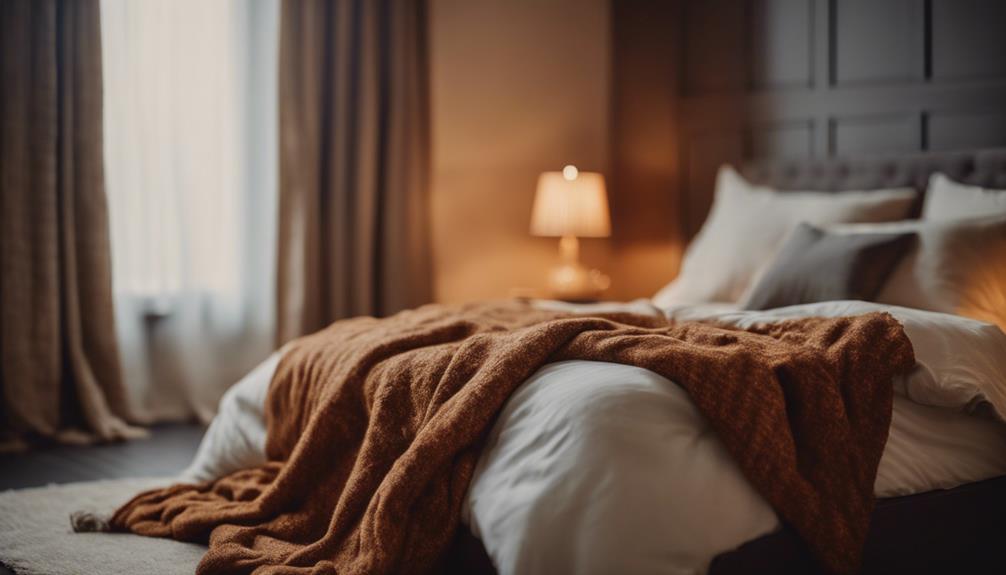
With seasonal coordination, bed throws can effortlessly transform the ambiance of your bedroom throughout the year. Here are five ways seasonal throw choices can enhance your bedroom decor:
- Switch Out Throws: Rotate between cozy, warm fabrics like wool or fleece for the colder months and lighter materials such as cotton or linen for a fresh look in summer.
- Match Changing Decor: Coordinate your throw with the evolving color scheme or theme in your bedroom to keep things looking cohesive.
- Add a Cozy Touch: Embrace thicker, warmer throws in the winter to create a snug and inviting atmosphere.
- Create a Breezy Look: Opt for lighter weight throws during warmer seasons to bring a sense of airiness and freshness to your bed.
- Easy Style Updates: By simply swapping out your throw, you can give your room a seasonal makeover without the need for a complete redesign.
Extended Bedding Lifespan
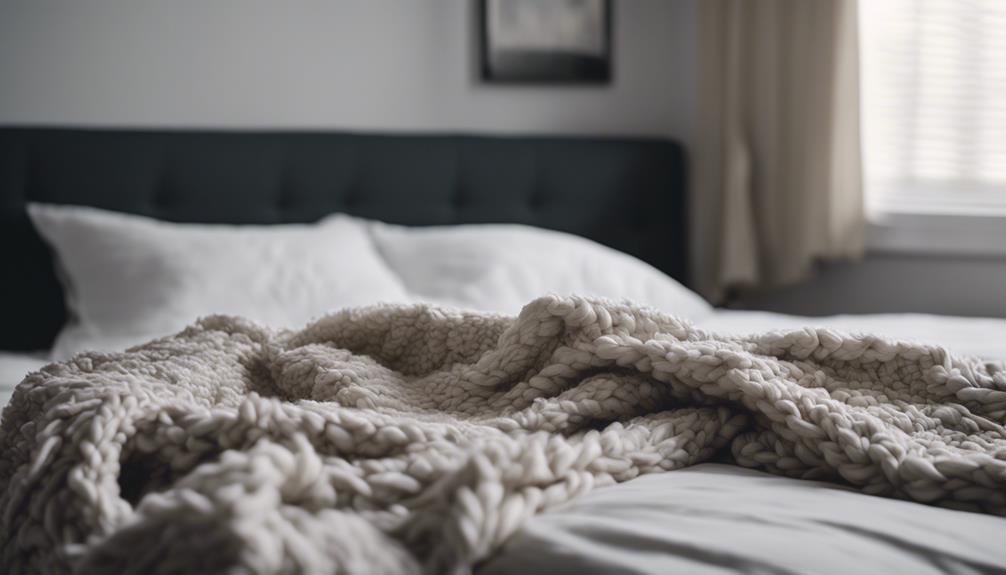
To extend the life of your bedding and protect it from spills and wear, consider using a throw on your bed. Throws play an important role in prolonging the lifespan of your bedding by acting as a shield against spills, stains, and the everyday wear and tear that bedding endures. They create a barrier between your body and the main bedding, reducing the need for frequent washing or dry cleaning of your main bedding items.
Additionally, throws offer a practical solution to easily switch up your bedroom decor without investing in new bedding sets. They can be washed or replaced effortlessly, providing a cost-effective way to refresh your bedroom style while preserving your main bedding.
In addition, throws add a layer of warmth and coziness during colder nights without adding extra bulk to your main bedding, ensuring both comfort and longevity for your bedding essentials. Incorporating a throw on your bed not only enhances the aesthetic appeal of your bedroom but also contributes to the practicality and durability of your bedding.
Fresh and Inviting Look
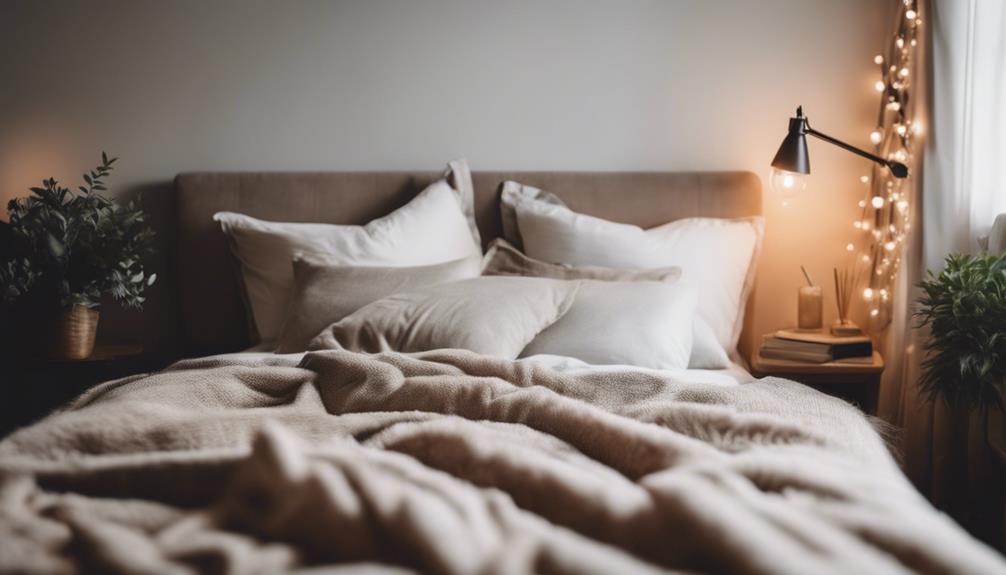
Adding a throw to your bed instantly elevates the room's ambiance with texture, color, and warmth. Here are five ways a throw can give your bed a fresh and inviting look:
- Texture: Throws come in various materials like soft fleece, cozy knit, or luxurious faux fur, adding depth and tactile appeal to your bed.
- Color: Choose a throw in a hue that complements your bedding or adds a pop of color to create a focal point in the room.
- Warmth: During colder months, a throw not only adds visual interest but also provides an extra layer of warmth for chilly nights.
- Style Update: Easily switch out throws to match different seasons or update your room's style without the need for a complete bedroom makeover.
- Cozy Atmosphere: Draping a throw casually over the corner of the bed creates a cozy and inviting feel, making your bed more welcoming and comfortable.
Frequently Asked Questions
Why Do You Need a Throw Blanket?
Why do you need a throw blanket?
Throws aren't only cozy additions to your bed; they also offer quick style updates for your room. Providing a splash of color or texture, they elevate your bedroom decor effortlessly. Plus, throws are versatile – perfect for snuggling up with a book or binge-watching your favorite show.
They serve a practical purpose too, safeguarding your bedding from spills and pet hair. So, why not add a throw to your bed for both comfort and flair?
Do You Sleep With a Throw Blanket?
Yes, you do sleep with a throw blanket. It's a cozy addition to your bedding, offering warmth and style.
Whether for extra comfort or as a decorative touch, a throw blanket can enhance your sleep experience. Its versatility allows for adjusting warmth levels to suit your preference.
Why Do People Use Throws?
When you think about why people use throws, the answer is clear: versatility. Throws provide an effortless way to update your bedroom's style without breaking the bank.
They offer a layer of warmth and comfort while adding a decorative touch to your bedding. Plus, throws help protect your bedspread from spills and stains.
What Is the Purpose of a Bed Spread?
A bedspread serves as both a practical and stylish addition to your bed. It covers the entire bed, including pillows, adding a decorative touch to your bedroom.
Bedspreads are lightweight and quilted, perfect for warmer nights when you want a bit of extra coverage without overheating. They come in various designs and fabrics, allowing you to easily change the look of your room and make a statement with your bedding choice.
How Does a Throw Pillow Serve a Purpose on a Bed?
When it comes to the size of throw pillows for a queen bed, it’s all about adding visual interest and comfort. These pillows can provide support while sitting up in bed, and create a layered, inviting look when paired with larger bed pillows. They serve as both functional and decorative elements in the bedroom.
Conclusion
So, the next time you're wondering about the point of a throw on a bed, remember all the benefits it brings!
From adding an extra layer of warmth to protecting your bedding and giving your room a fresh look, throws aren't just decorative but also practical.
So why not try adding one to your bed and see how it can elevate your space?
Who knew a simple throw could make such a difference!
Decorative Throws
Can Throw Pillows Be Donated
Intrigued about donating throw pillows? Learn where and how to donate for a positive impact on your community.

Yes, throw pillows can be donated to places like local charities, homeless shelters, thrift stores, and animal shelters. Donating throw pillows not only provides comfort but also supports those in need within the community. Before donating, make sure the pillows are clean, in good condition, and free of odors. Follow specific guidelines from the organization and consider repairing any tears or loose seams. By donating throw pillows, you can make a positive impact on both individuals and the environment. Additional details on guidelines, benefits, and donation opportunities are available for those interested in contributing to a good cause.
Key Takeaways
- Cleanliness and good condition are essential for donation.
- Verify organization-specific acceptance criteria before donating.
- Repurpose throw pillows at homeless shelters or animal shelters.
- Contact local charities or thrift stores for donation opportunities.
- Ensure hypoallergenic filling and safety for recipients.
Where to Donate Throw Pillows
When donating throw pillows, it's important to reach out to local charities, homeless shelters, and thrift stores. These organizations often accept gently used throw pillows to provide comfort and support to those in need.
Additionally, animal shelters may welcome clean and intact throw pillows for bedding purposes. Before donating, be sure to contact these charities, homeless shelters, thrift stores, or animal shelters to inquire about their specific donation policies for throw pillows.
By donating throw pillows, not only do you help reduce waste, but you also support community members who can benefit from these items. Whether it's through charities, homeless shelters, thrift stores, or animal shelters, your donations can make a meaningful impact on those who can use a little extra comfort and support.
Be sure to check with each organization for any guidelines or restrictions they may have in place regarding throw pillow donations.
Guidelines for Donating Throw Pillows
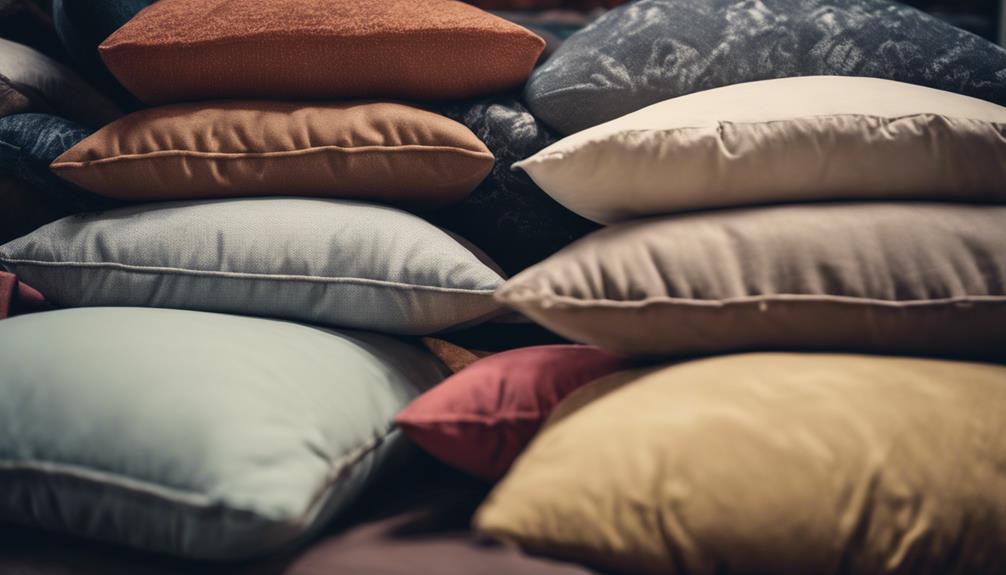
When contemplating donating throw pillows, it's vital to adhere to the guidelines provided by charitable organizations.
These may encompass donation eligibility criteria, cleanliness and condition standards, as well as specific instructions for the donation process.
Donation Eligibility Criteria
Maintaining cleanliness, good condition, and odor-free quality in throw pillows is vital for their eligibility for donation.
Before donating throw pillows, it's important to check with donation centers for specific guidelines on accepting them. Some organizations may welcome decorative throw pillows for charitable purposes, but restrictions on the types of throw pillows accepted can vary.
By confirming these details, you can guarantee that your donation meets the criteria set by the donation centers.
Donating throw pillows not only provides comfort and support to those in need but also helps in reducing waste by giving a new life to items that are still in good condition. It's a simple way to make a positive impact and help others in your community.
Cleanliness and Condition Standards
Before donating throw pillows, it's important to uphold cleanliness and condition standards to guarantee their eligibility for donation. Guidelines often require throw pillows to be clean, unstained, odor-free, and in good condition. Most donation centers won't accept pillows that are torn, heavily worn, or pest-infested.
They should also be free of pet hair, allergens, and visible damage. To be considered for donation, throw pillows must be gently used, without flattened fillings or excessive fading. Following these standards ensures that charitable organizations can effectively repurpose donated throw pillows.
It's crucial to ensure that the pillows are in a condition that aligns with these criteria to maximize their chances of being accepted for donation.
Donation Process Instructions
To donate throw pillows effectively, confirm acceptance with charitable organizations and ensure they meet cleanliness and condition standards.
When initiating the donation process, reach out to local thrift stores or charitable organizations to inquire about their policies on accepting gently used throw pillows.
It's crucial to verify that the throw pillows are in good condition, clean, and meet the donation criteria set by the organization.
Consider donating to homeless shelters, charities, or even animal shelters in need of bedding.
Cleaning and Preparing Throw Pillows
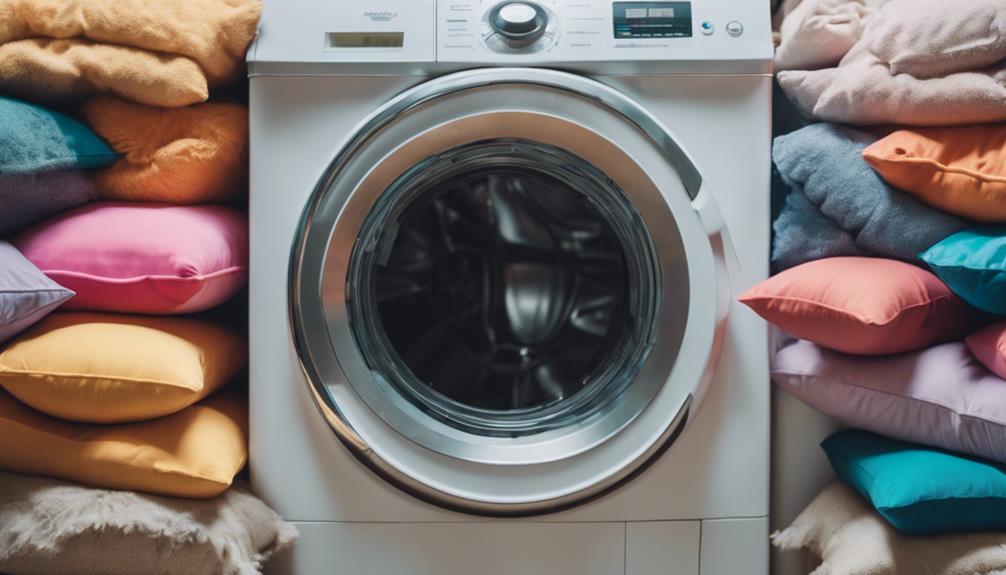
When preparing throw pillows for donation, it's important to follow the care instructions for washing to make sure they're clean and fresh. Old throw pillows may appear yellowed or stained, but with proper cleaning, they can be restored to a like-new condition.
Some donation centers or shelters may sometimes accept older throw pillows as long as they're in good repair and free of odors. Before donating, check the brand and quality of the pillows; reputable brands may be more desirable for donation. If the throw pillows are blue, make sure that the color is vibrant and not faded.
Repair any tears or loose seams on the pillows to ensure they've an extended lifespan after donation. Fluffing and reshaping the pillows can help restore their appearance and appeal, making them more attractive for donation to those in need.
Benefits of Donating Throw Pillows

Donating throw pillows can make a significant impact by providing comfort to those in need and creating a welcoming atmosphere in various charitable settings.
Additionally, repurposing throw pillows for donation can contribute to environmental sustainability by reducing waste in landfills.
These benefits highlight the positive outcomes that can arise from a simple act of donating throw pillows.
Donation Impact
Embracing generosity by donating throw pillows can greatly enhance the well-being of those in need. When considering the impact of your donation, it's important to recognize the positive effects it can have on both individuals and the community. Donated throw pillows provide comfort and warmth to those in homeless shelters or animal shelters, promoting a sense of care and support. These acts of generosity also contribute to sustainability by extending the useful life of items, reducing waste in landfills. Charitable organizations often repurpose donated throw pillows for various purposes, such as pet bedding or cushioning for furniture. By supporting those facing challenges and providing essential items, your donation can truly make a difference in the lives of others.
| Donation Impact |
|---|
| Comfort |
| Sustainability |
| Repurpose |
| Community Support |
| Cost Savings |
Environmental Benefits
Supporting sustainability efforts, donating throw pillows helps reduce waste in landfills and benefits both the environment and those in need. By repurposing throw pillows through donation, we prevent them from ending up in the trash, giving them a chance for new homes and uses.
Charitable organizations and shelters welcome donated throw pillows to support their programs, contributing to circular economy practices that extend the products' life cycles. This act not only minimizes waste but also promotes environmental consciousness and resource efficiency.
Through donating throw pillows, we actively participate in reducing our ecological footprint, fostering a more sustainable future for all. Join us in making a positive impact by embracing donation as a way to give back and protect our planet.
Impact of Donating Throw Pillows

By donating gently used throw pillows, we contribute to reducing waste in landfills and supporting sustainability efforts. When we donate throw pillows instead of throwing them away, we help in repurposing these items for various purposes, preventing them from ending up as waste.
Charities, animal shelters, and homeless shelters can benefit from the donation of throw pillows, providing comfort and support to those in need. Additionally, some thrift stores accept throw pillow donations to give them a new life by reselling them or donating them to individuals or families who could use them.
It's important to check with local organizations to make sure they accept throw pillow donations for those in need, as different places may have varying requirements or preferences. Through our actions of donating throw pillows, we not only declutter our homes but also make a positive impact on the environment and the community around us.
Donation Centers Accepting Throw Pillows
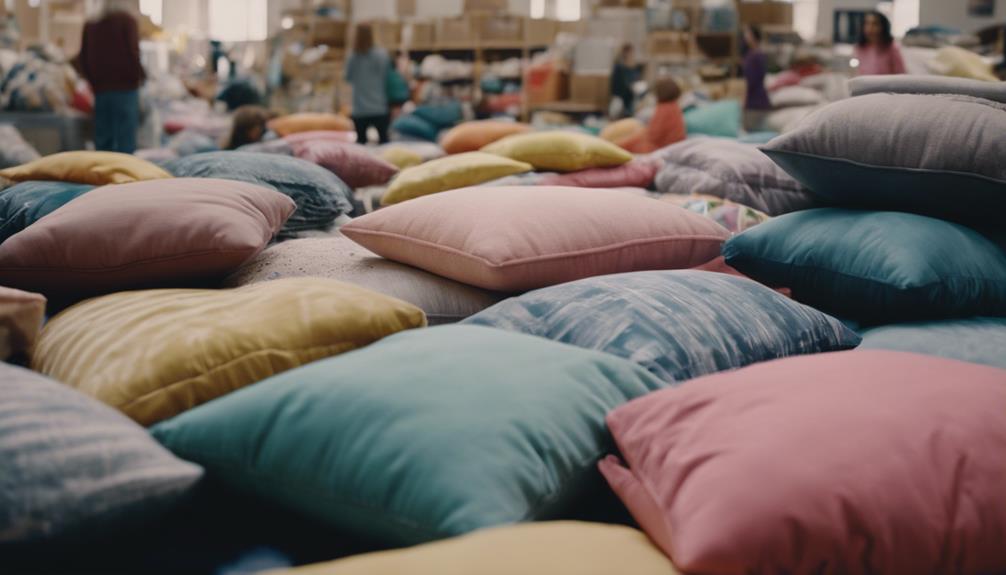
When seeking to donate throw pillows, it's advantageous to locate donation centers that accept these items to guarantee they find new homes and uses. Some donation centers, homeless shelters, and thrift stores may welcome gently used throw pillows for individuals in need.
Additionally, daycares and animal shelters might repurpose donated throw pillows for animal bedding or other purposes, contributing to reducing waste in landfills. It's worth checking with local charities or secondhand shops to inquire about programs that accept throw pillows for donation.
Considerations Before Donating Throw Pillows
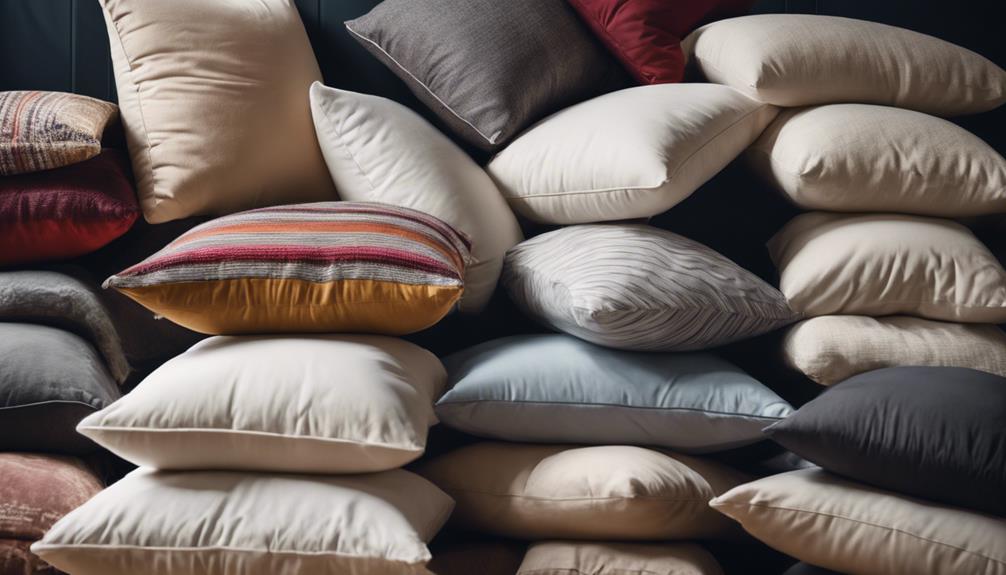
Before donating throw pillows, it's important to assess their condition to make sure they're clean, intact, and free from odors. When considering donation, it's important to keep in mind the following:
- Check with donation centers or organizations in advance, as not all may accept throw pillows due to hygiene concerns.
- Some charities welcome gently used throw pillows for various purposes, such as decorating shelters or providing comfort to those in need.
- Note that animal shelters mightn't accept throw pillows due to choking hazards or potential damage caused by pets.
Ensuring Throw Pillows Are Donation-Ready
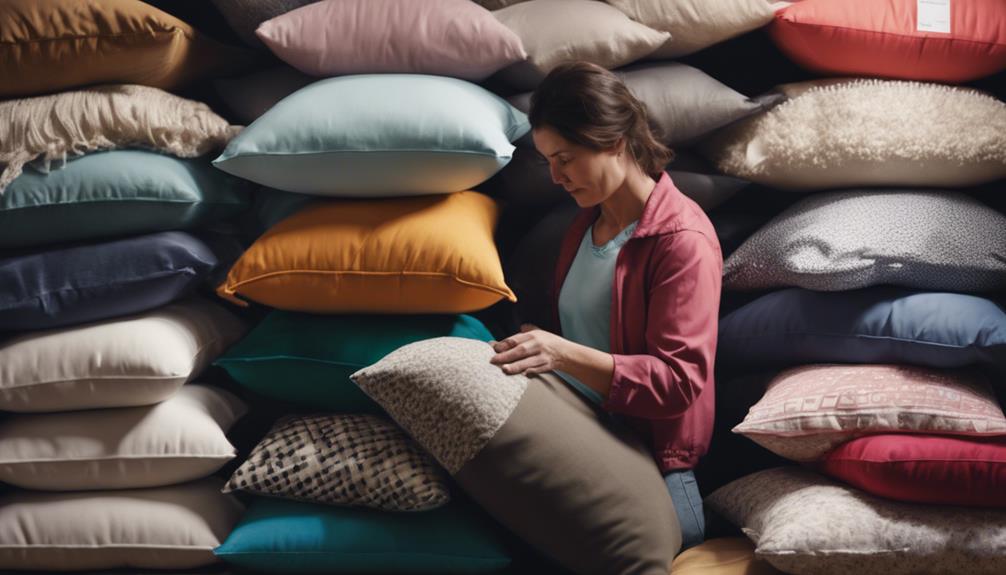
To prepare throw pillows for donation, make sure they are clean, odor-free, and in good condition. It is important to guarantee that the throw pillows are donation-ready by meeting these criteria. Additionally, checking if the filling material is hypoallergenic can ensure the safety of the recipients. Some organizations may have specific requirements, such as only accepting new or gently used throw pillows to maintain quality standards. Consider donating throw pillows with removable, washable covers for easier maintenance by those who receive them.
| Criteria | Description | Importance |
|---|---|---|
| Clean | Wash or spot clean the pillows | Essential |
| Odor-free | Ensure no unpleasant smells are present | Vital |
| Good Condition | Check for tears, stains, or deformities | Essential |
Spreading Comfort Through Pillow Donations

Let's continue our focus on the impact of pillow donations by exploring how providing comfort through these donations can positively affect individuals in need. When we donate throw pillows, we aren't just giving away items; we're spreading warmth and support to those who may be facing difficult circumstances. Here are three ways in which pillow donations can make a difference:
- Charitable Efforts: Many organizations, including homeless shelters and daycares, welcome throw pillow donations as part of their charitable efforts. By contributing in this way, we can help enhance the quality of life for those who benefit from these donations.
- Repurposing Textiles: Repurposing throw pillows for animal shelters or other charitable purposes can have a significant impact on the community. These donations can provide comfort to animals in need while also reducing waste and benefiting the environment.
- Comfort and Warmth: Giving throw pillows a new life through donation spreads comfort and warmth to individuals facing challenges. The simple act of donating a pillow can bring a sense of coziness and care to those who receive it.
Frequently Asked Questions
Should I Donate or Throw Away Pillows?
We should donate pillows if they're clean and in good condition. Many organizations accept gently used pillows for donation, benefiting those in need and reducing waste.
Pillows can also be repurposed for animal bedding or other charitable purposes to prevent them from going to landfills. Check with local shelters or donation centers to see if they accept pillow donations for specific needs.
It's a simple way to make a positive impact on both people and the environment.
What to Do With Unwanted Pillows?
When deciding what to do with unwanted pillows, there are several options to consider. You can repurpose them for pet bedding, floor cushions, or draft stoppers. Another option is to donate them to homeless shelters, animal shelters, or thrift stores. You can also upcycle them into gardening cushions, packing material, or insulation for moving. It's important to verify donation policies with organizations first. If none of these options are viable, you can recycle the pillows through textile programs to reduce waste.
Repurposing or donating unwanted pillows is not only beneficial for sustainability but also helps those in need.
How Do I Dispose of Old Pillows Near Me?
When it comes to disposing of old pillows near us, it's crucial to choose eco-friendly options. Local textile recycling centers and services like the American Textile Recycling Service offer convenient ways to recycle old pillows responsibly.
Textile factories also repurpose these pillows into new products, contributing to waste reduction. With over 287 million pounds of textiles recycled to date, including pillows, proper disposal helps prevent harmful synthetic materials from ending up in landfills.
Can You Give Pillows to Charity?
We recommend against donating throw pillows due to hygiene concerns. Such items are often not accepted by charities like animal shelters, homeless shelters, and daycares. The risk of bacteria, dust mites, and allergens makes pillows unsuitable for donation.
Always check with organizations beforehand to see if they accept pillow donations. Consider repurposing or recycling old pillows instead of donating them to guarantee hygiene and safety standards are met.
Conclusion
To sum up, donating throw pillows can make a meaningful impact on those in need. By following guidelines for cleaning and preparing them, you can guarantee they're ready for donation.
Consider donating to local centers that accept throw pillows to spread comfort and support. So, why not make a difference today by donating your throw pillows to help those in need?
-
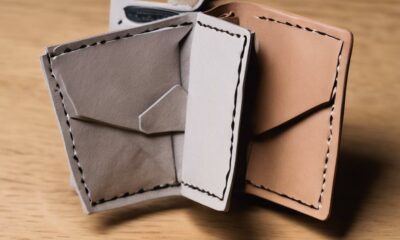
 Vetted1 month ago
Vetted1 month ago14 Best Personalized Father's Day Gifts for Your Husband – Show Him You Care
-

 Alfresco1 month ago
Alfresco1 month agoAlfresco Stacker Doors: Seamless Indoor-Outdoor Living!
-

 Craft and Textiles3 months ago
Craft and Textiles3 months ago15 Best Places to Buy Appliances for Your Home – Top Retailers Reviewed
-

 Decorative Throws3 months ago
Decorative Throws3 months agoIs It Better to Dry Clean Blankets?
-

 Tableware and Dining Accessories3 months ago
Tableware and Dining Accessories3 months agoWhat Is the Meaning of the Word Tableware
-

 Tableware and Dining Accessories3 months ago
Tableware and Dining Accessories3 months agoWhat Is the Hindi Meaning of Tableware
-
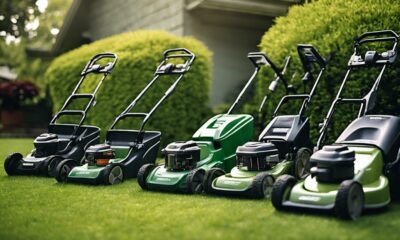
 Craft and Textiles3 months ago
Craft and Textiles3 months ago15 Best Cordless Mowers for Effortless Lawn Care – Top Picks of 2024
-

 Yarn3 months ago
Yarn3 months agoIs Yarn Natural or Manmade? Unravel the Truth























